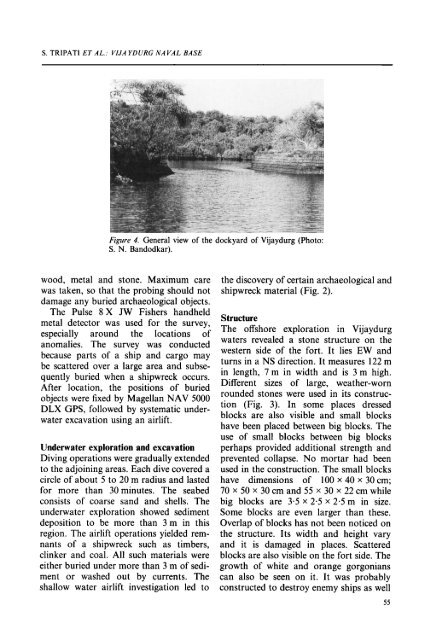Marine archaeological exploration and excavation of Vijaydurg—a ...
Marine archaeological exploration and excavation of Vijaydurg—a ...
Marine archaeological exploration and excavation of Vijaydurg—a ...
You also want an ePaper? Increase the reach of your titles
YUMPU automatically turns print PDFs into web optimized ePapers that Google loves.
S. TRIPATI ET AL.: VlJA YDURG NA VAL BASE<br />
Figure 4. General view <strong>of</strong> the dockyard <strong>of</strong> Vijaydurg (Photo:<br />
S. N. B<strong>and</strong>odkar).<br />
wood, metal <strong>and</strong> stone. Maximum care<br />
was taken, so that the probing should not<br />
damage any buried <strong>archaeological</strong> objects.<br />
The Pulse 8 X JW Fishers h<strong>and</strong>held<br />
metal detector was used for the survey,<br />
especially around the locations <strong>of</strong><br />
anomalies. The survey was conducted<br />
because parts <strong>of</strong> a ship <strong>and</strong> cargo may<br />
be scattered over a large area <strong>and</strong> subse-<br />
quently buried when a shipwreck occurs.<br />
After location, the positions <strong>of</strong> buried<br />
objects were fixed by Magellan NAV 5000<br />
DLX GPS, followed by systematic under-<br />
water <strong>excavation</strong> using an airlift.<br />
Underwater <strong>exploration</strong> <strong>and</strong> <strong>excavation</strong><br />
Diving operations were gradually extended<br />
to the adjoining areas. Each dive covered a<br />
circle <strong>of</strong> about 5 to 20 m radius <strong>and</strong> lasted<br />
for more than 30minutes. The seabed<br />
consists <strong>of</strong> coarse s<strong>and</strong> <strong>and</strong> shells. The<br />
underwater <strong>exploration</strong> showed sediment<br />
deposition to be more than 3m in this<br />
region. The airlift operations yielded rem-<br />
nants <strong>of</strong> a shipwreck such as timbers,<br />
clinker <strong>and</strong> coal. All such materials were<br />
either buried under more than 3 m <strong>of</strong> sedi-<br />
ment or washed out by currents. The<br />
shallow water airlift investigation led to<br />
the discovery <strong>of</strong> certain <strong>archaeological</strong> <strong>and</strong><br />
shipwreck material (Fig. 2).<br />
Structure<br />
The <strong>of</strong>fshore <strong>exploration</strong> in Vijaydurg<br />
waters revealed a stone structure on the<br />
western side <strong>of</strong> the fort. It lies EW <strong>and</strong><br />
turns in a NS direction. It measures 122 m<br />
in length, 7 m in width <strong>and</strong> is 3 m high.<br />
Different sizes <strong>of</strong> large, weather-worn<br />
rounded stones were used in its construc-<br />
tion (Fig. 3). In some places dressed<br />
blocks are also visible <strong>and</strong> small blocks<br />
have been placed between big blocks. The<br />
use <strong>of</strong> small blocks between big blocks<br />
perhaps provided additional strength <strong>and</strong><br />
prevented collapse. No mortar had been<br />
used in the construction. The small blocks<br />
have dimensions <strong>of</strong> 100 x 40 x 30 cm;<br />
70 x 50 x 30 cm <strong>and</strong> 55 x 30 x 22 cm while<br />
big blocks are 3.5 x 2-5 x 2.5 m in size.<br />
Some blocks are even larger than these.<br />
Overlap <strong>of</strong> blocks has not been noticed on<br />
the structure. Its width <strong>and</strong> height vary<br />
<strong>and</strong> it is damaged in places. Scattered<br />
blocks are also visible on the fort side. The<br />
growth <strong>of</strong> white <strong>and</strong> orange gorgonians<br />
can also be seen on it. It was probably<br />
constructed to destroy enemy ships as well<br />
55
















